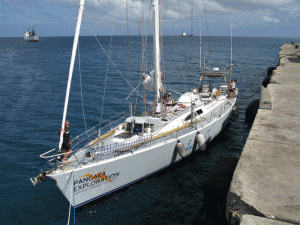Equatorial Pacific
What’s so special about the equatorial Pacific?
In September 2012, graduate students Liz Drenkard and Alice Alpert, and dive operations manager Pat Lohmann flew into Kiritimati (Christmas Island), Republic of Kiribati, where they joined the crew of Pangea Explorations’ vessel Sea Dragon (http://www.panexplore.com/) for a 30 day expedition across the central Equatorial Pacific. Our goal was to survey and sample seawater, and coral skeletons and tissue on 3 coral reef islands dotted across 2000 miles of remote equatorial Pacific Ocean. Chip Young, of NOAA’s Coral Reef Ecosystem Division, and Kelsey Erensberger of US Fish and Wildlife joined our team. The expedition was funded with support from the National Science Foundation to Anne Cohen and Kristopher Karnauskas (NSF#OCE-1031971).
The central tropical Pacific is special because it is home to many of the world’s most pristine coral reef ecosystems, including the second largest marine protected area in the world – the Phoenix Islands MPA or PIPA. But this region of the ocean is warming more rapidly than other tropical areas, making the corals that build the reefs more vulnerable to mass bleaching, and mortality. However, along the equator, the Pacific Equatorial Undercurrent (EUC) delivers cool, nutrient rich water to the west sides of coral reef islands located in its path. The EUC is strengthening with global warming, and for corals on the equatorial islands this process may mitigate or slow the warming enough to prevent bleaching. Our expedition took us to 3 of these islands, Jarvis and Howland (both US Territories) and Maiana in the Gilbert Islands. Our goals were to deploy instruments and collect samples that will allow us to both characterize the seawater environment on the living reef (e.g., thermal structure, carbonate system chemistry, nutrient concentrations) and to investigate the connection between reef seawater and the EUC. We collected coral samples to study the effect of the EUC on coral growth and we collected tissue samples to analyze their fat content as well as the types of algal symbionts in the coral tissue. These measures, at these three sites, will give us a good idea of whether and how the EUC impacts the corals that build the reefs, and whether the EUC affords protection to the corals as tropical temperatures rise. With this information, we can then make a start at predicting whether and how a strengthening EUC will mitigate the impact of tropical warming for the suite of equatorial coral reef islands in its path.
